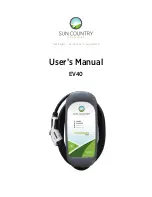
10
STEP 8 – DISCONNECTION.
Ensure the power selection switch is set to the ‘OFF’ position and disconnect from the
240V supply.
Battery out of vehicle
Remove the BLACK lead (battery clip) from the battery. Remove the RED lead (battery
clip) from the battery.
Battery in vehicle
Remove the chassis connection. Remove the battery terminal connection.
ENGINE START FUNCTION
STEP 1 TO 3 –
Follow STEPS 1 to 3 of the charging instructions of this booklet.
STEP 4 – SET BATTERY VOLTAGE
Set the battery charger to either 12V or 24V depending on the battery voltage of the
vehicle you are starting.
STEP 5 –
Set the adjustable charge rate to 30Amps in ‘AUTO’ or ‘MANUAL’ mode via
the adjustable charge rate dial, allow the battery charger to charge the vehicles battery
for 5 minutes.
STEP 6 –
Press the ‘CHARGE/ENGINE START’ switch down to ‘ENGINE START’.
STEP 7 –
Turn the car’s ignition key to start the engine.
STEP 8 –
If engine fails to start after 3 seconds repeat instructions step STEP 5 & 6,
before attempting to start the engine again.
NOTE: Do not repeat this operation more than 5 times.
CALCIUM BATTERY CHARGING
OR EQUALIZATION CHARGE
Calcium batteries are becoming more commonly sold as they have a longer shelf
life (4 times longer than a lead antimony battery), they also have a better ability to
withstand higher engine bay temperatures, and have increased cranking output. They
also require a different charging technique when left flat or when deeply discharged.
STEP 1 TO 3 –
Follow STEPS 1 to 3 of the charging instructions of this booklet. Ensure
that the battery is removed from the vehicle to prevent the batteries electrolyte from
spilling over and damaging the car or engine bay.


































